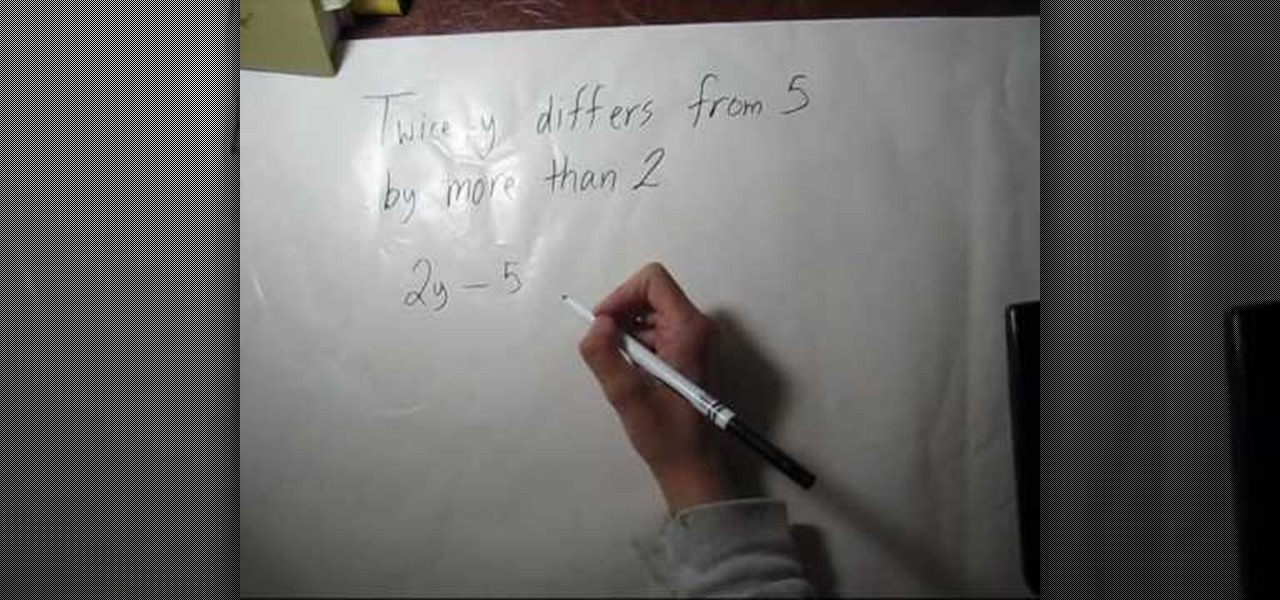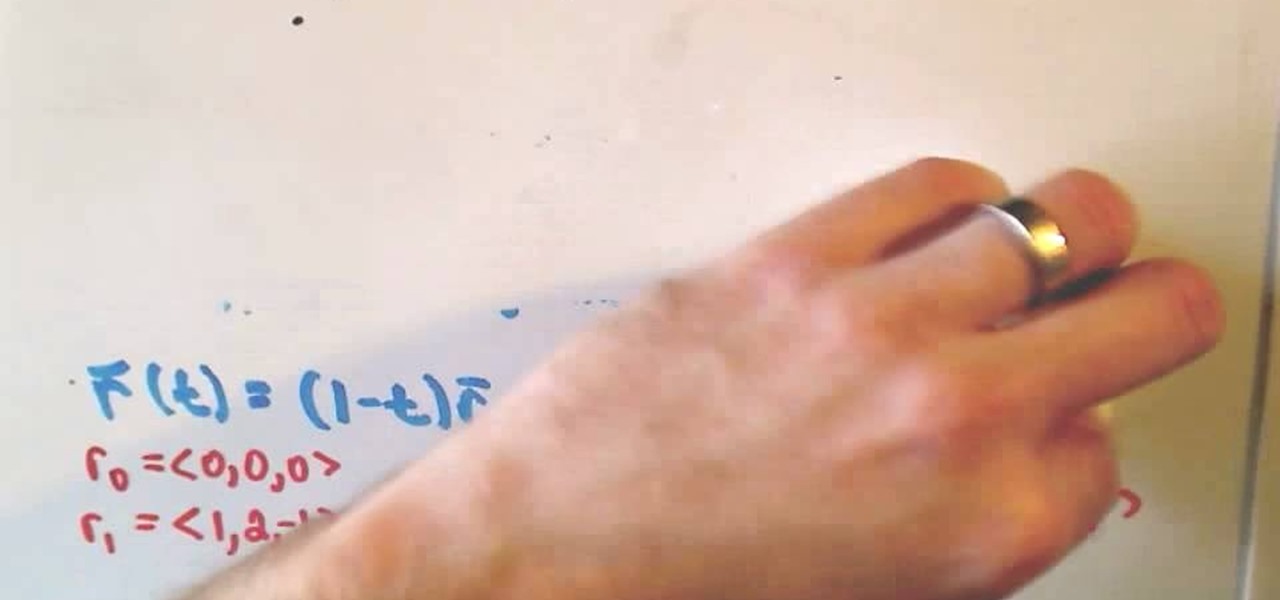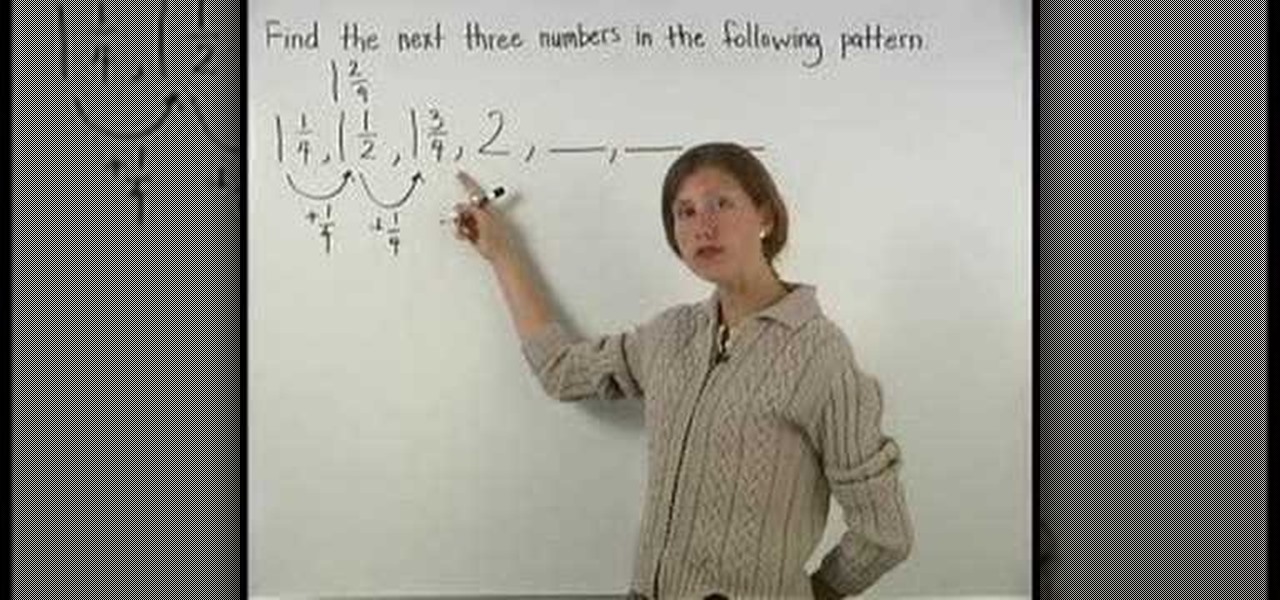Math How-Tos

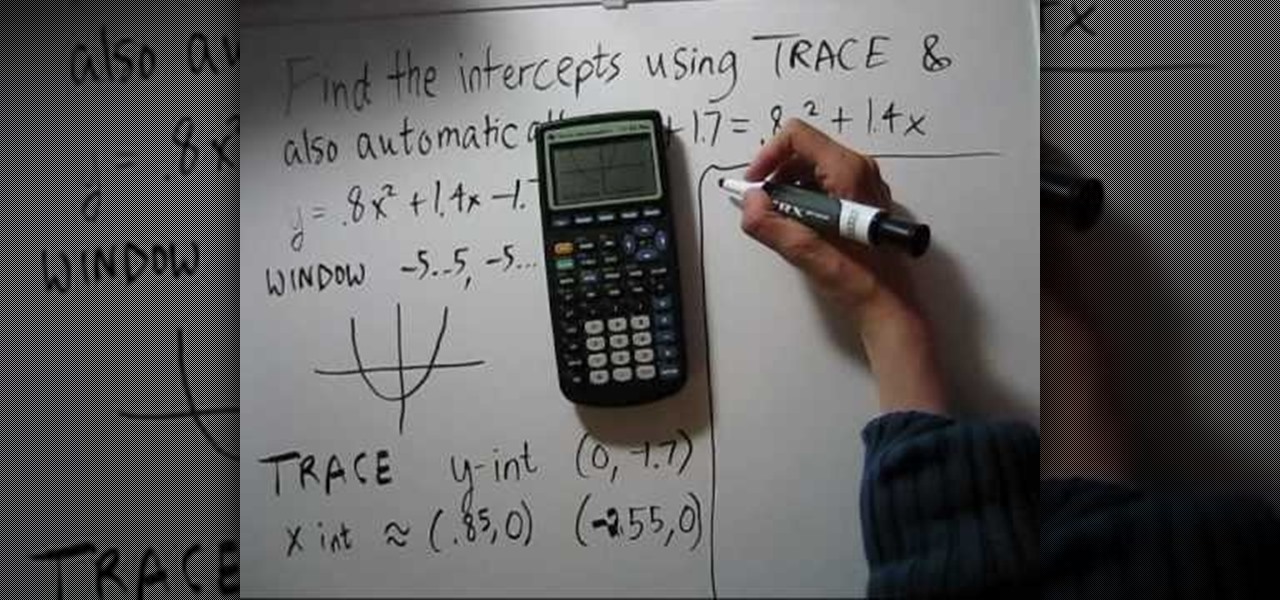
How To: Find intercepts on a calculator TI-83
NotesCollegeAlgebra teaches you how to find intercepts on a calculator TI-83. You start with y plus 1.7 equals .8 times x squared plus 1.4 times x. First you subtract 1.7 from both sides, you get y alone on one side. The window should be set to -5...5, -5...5. X scale should be at 1, y scale at 1 and x rez at 1. Make a graph for it, like a parabola. Use trace to get y intercept at negative 1.7. The x intercept is about .85. Continue to use the calculator to get all the values that you need.
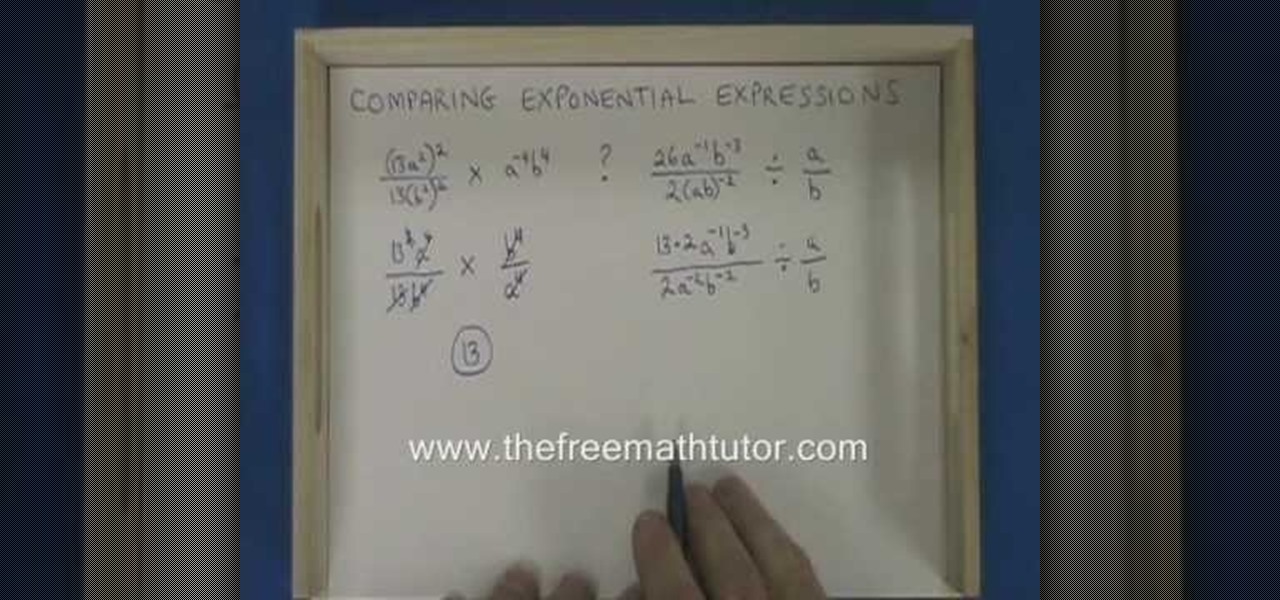
How To: Compare exponential expressions
In this video the tutor shows how to compare exponential expressions and judge if they are equivalent. He shows how to do this using examples to simply exponential expressions. Now after simplifying the numerator and denominator separately he reduces the fraction to arrive at a simple value. Now using this simple values we can compare them and judge if both their values are equivalent. This video gives a good introduction on how to simplify the exponential expression and how to compare them a...
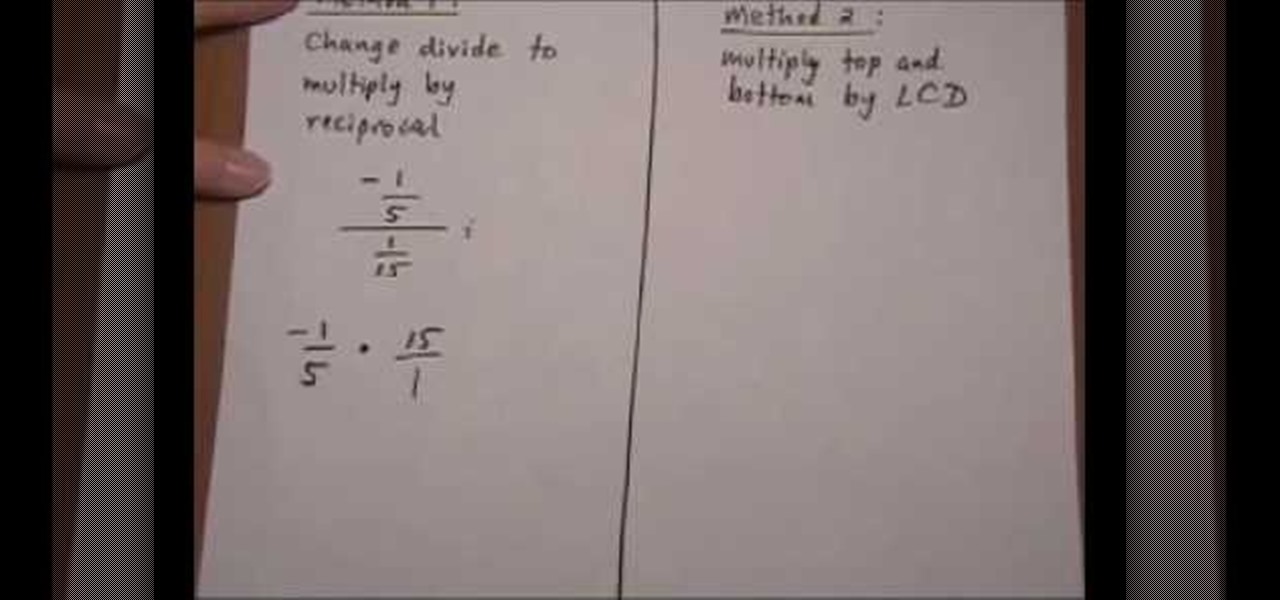
How To: Simplify complex fractions
In this video you can learn how to simplify complex fractions. Look at the example in the illustration. To simplify this complex problem, you would first add the number 1 under the whole number in the denominator, to make it a fraction. Then change it from a division problem by simply inverting (flipping the numbers over) in the second part of the problem. Then multiply the numerators and the denominators across and simplify the problem further, if necessary. To simplify this complex problem,...
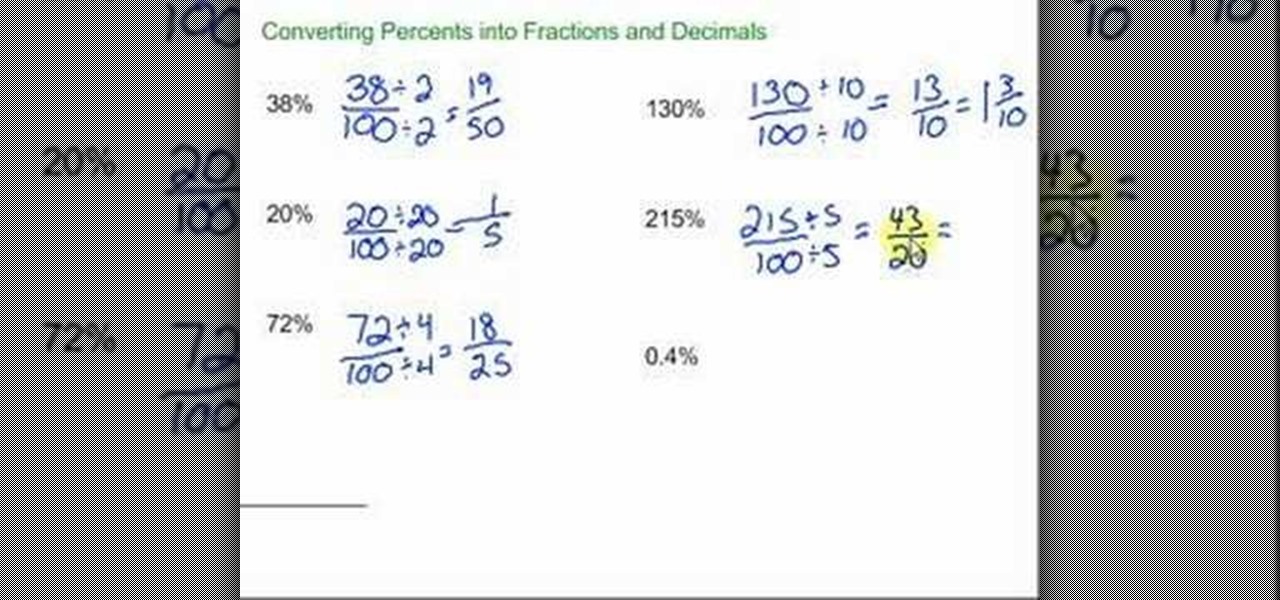
How To: Convert percents into fractions and decimals
This video shows you how to convert percents to fractions and decimals To convert percent to decimal or fraction it is important that we know the meaning of percent which is per 100. So to convert a percent to fraction is simply to put in over 100 and simplify. Now to convert percent to decimal is to move the decimal point two spots to the left. if you don't see a decimal point, it is understood that is behind the last digit of the number.
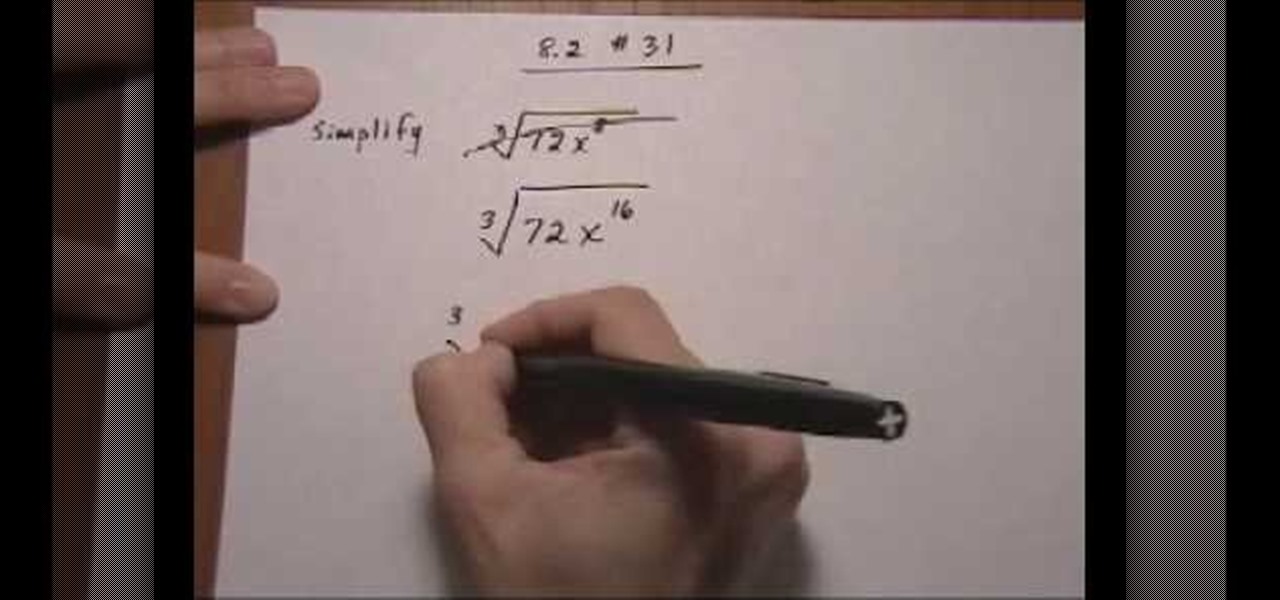
How To: Simplify cube roots
In this video, the narrator presents the viewer with a quick, painless way of simplifying cube roots. The narrator presents many methods to simplify square roots to appeal to different learning styles. By doing things like dividing the power by the root to figure out the power of a number x, the viewer is better able to tackle square-rooting numbers that may not have friendly roots. The video gets more complex as it goes on, eventually teaching the viewer to split the inside of a root up if t...

How To: Graph a linear equation using slope and y-intercept
In this video tutorial learn how to graph an equation using the slope and y-intercept. To show how this can be done, the equation 4X-5Y=20 is used as an example. The first step that needs to be done is to convert the equation into the y=mx+b format where m is the slope and b is the intersection of the y-intercept. Simply solve the equation for Y and you get Y=4/5X-4. From this, you will find that the slope, or m, is equal to 4/5 and that b is the coordinates 0 and -4. On the graph, you will w...
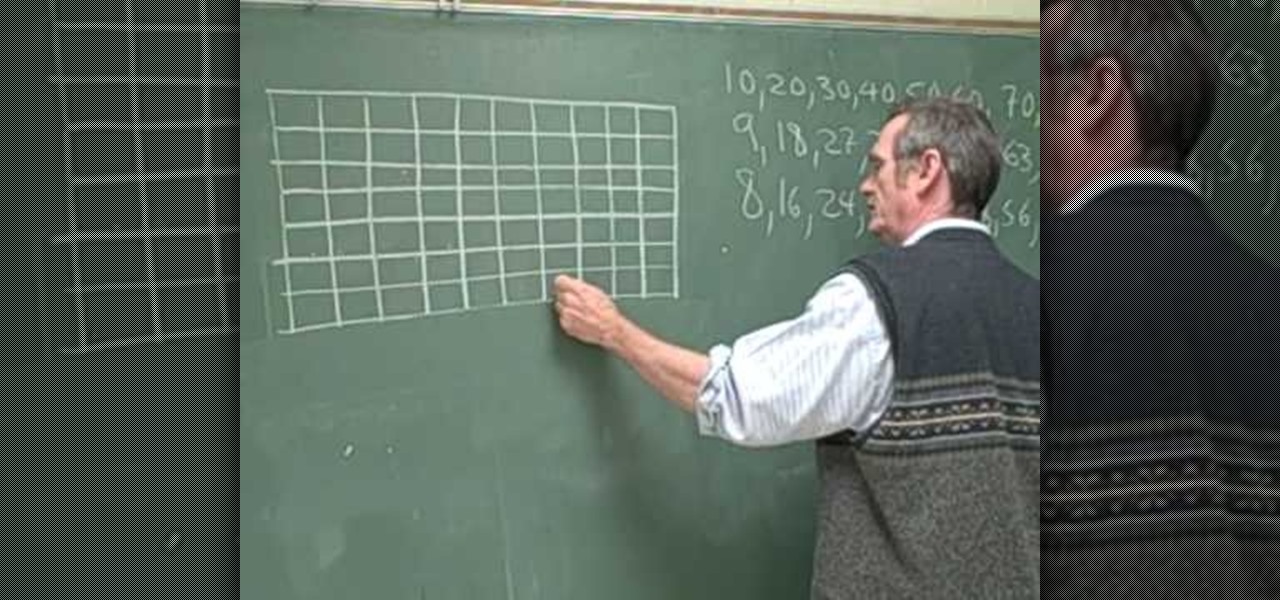
How To: Teach your children to multiply early
The gentleman, acting as the Instructor, starts the session immediately by suggesting that to teach early multiplication all parents should practice a method of "Count-by's" with their children when they are very young using ones to ten, twos to twenty, threes to thirty, fours to forty, and so forth. The Instructor then demonstrates this method of counting by tens using a grid behind him on a chalkboard which depicts columns of ten elements. He counts each column from 10 to 100, and then writ...
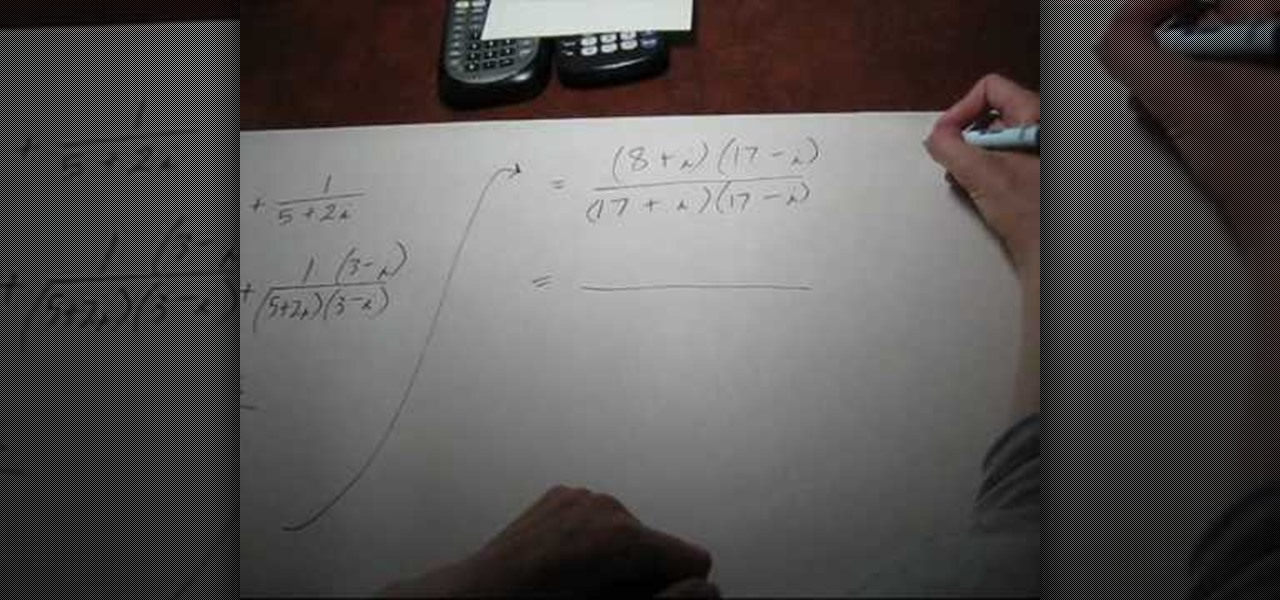
How To: Find the sum of reciprocals of complex numbers
In this tutorial the instructor shows how to calculate the sum of reciprocals of complex numbers. If you have to find out the sum of the reciprocals of two complex numbers first you will have to find out the least common multiple of the denominators. To do this multiply the numerator and denominator of the first fraction by the second complex number. Similarly multiply the numerator and denominator of the second fraction by the first complex number. Now you will have two fractions whose denom...
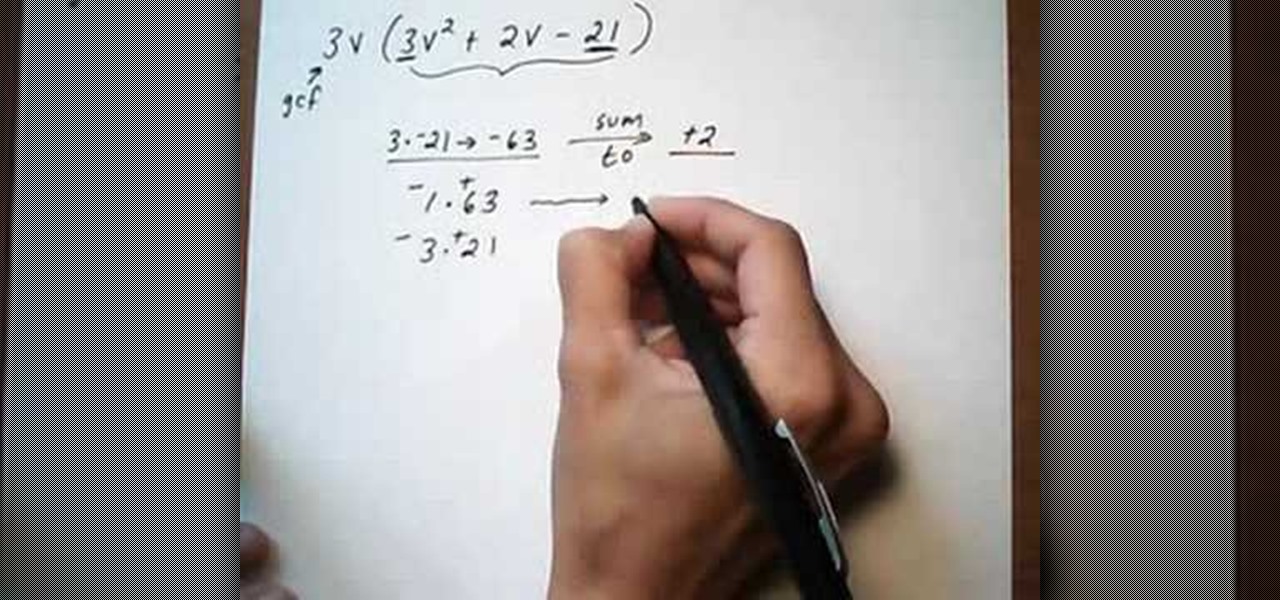
How To: Factor a trinomial by GCF then grouping
In this tutorial the instructor shows how to factor a trinomial with Greatest Common Factor (GCF) and then how to group it. The first thing you have to do when you want to factor a trinomial is look for the GCF. First factor the numerical coefficients of the terms of the equation. Now separate out the common numerical factor and if any common variable. This leaves you with a binomial to be factored. Now to solve this multiply the numerical coefficients of the first term and the last term and ...
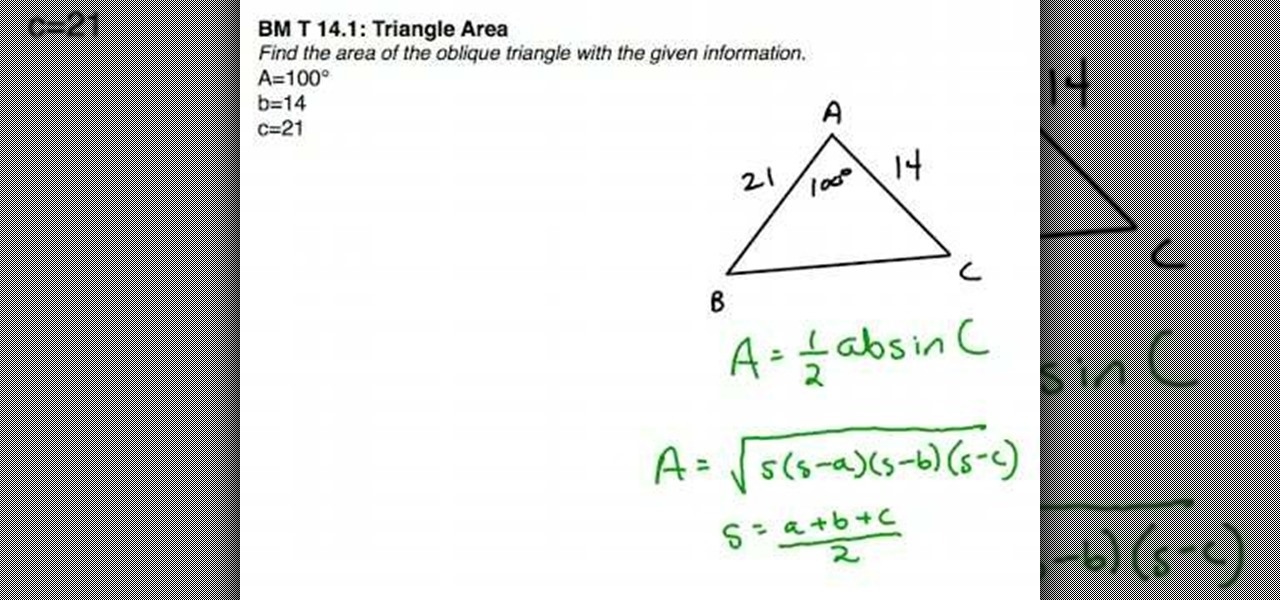
How To: Find the area of an oblique triangle using formulas
In this tutorial the instructor shows how to find the area of an oblique triangle using different formulas. To find the area of an oblique triangle there are different formulae. The first formula to calculate the area of a triangle is area A = (1/2) * a * b * Sin(C), where a and b are the lengths of the two sides of the triangle and C is the value of the angle of the triangle that lies in between the two sides a, b. Now substitute these values in the given formula to find the area if you have...
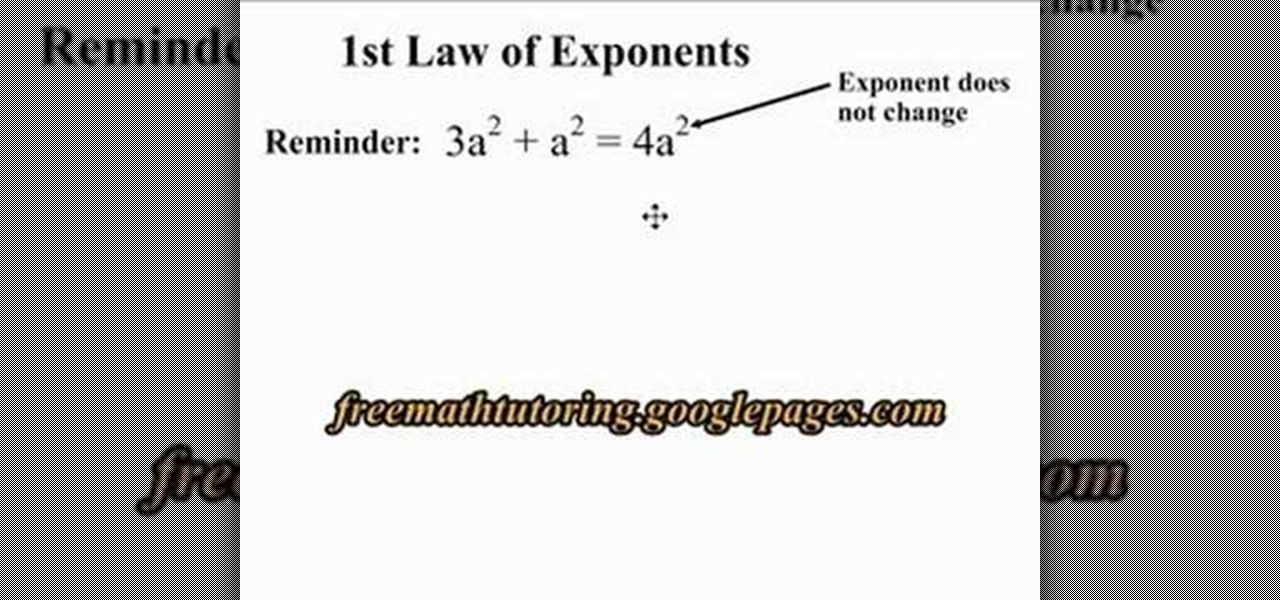
How To: Apply the 1st Law of Exponents
In this video tutorial the author explains the concept of 1st Law of Exponents using an example. He shows that when we add polynomials the exponents does not change but when you multiply two polynomials their exponents change. He says that the new exponent is the sum of the first polynomial exponent and the second polynomial exponent. He further demonstrates this with a good example. This video clear shows with an example about the concept of the 1st Law of Exponents using it to multiply two ...

How To: Evaluate logarithms using a calculator TI-83
A video to help calculator users find the natural logarithm (log base e, or "ln") and standard logarithm (log base 10, or simply "log") of any number using a TI-83 calculator (works for any issue of the TI-83 calculator or even a TI-84 calculator). Turn on your calculator. To find the natural log of a number, press the "ln" button (the third button from the bottom left), enter the number you want to find the natural log of, press the ")" (closed parenthesis) button, then press enter. The same...
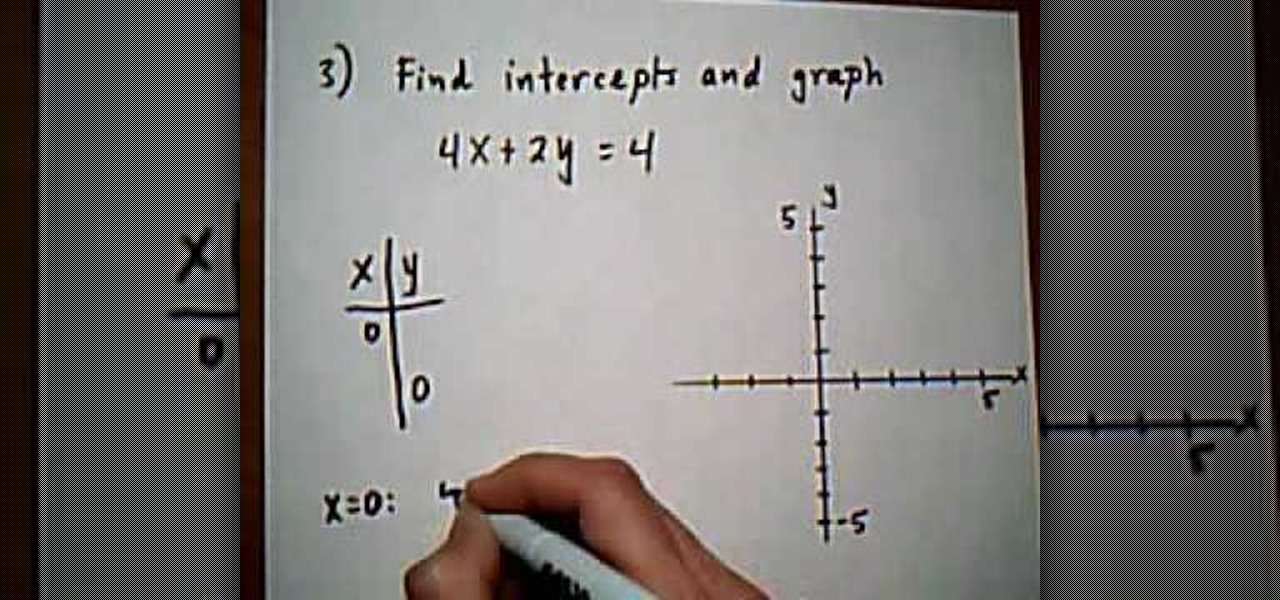
How To: Find intercepts & use them to graph linear equations
The first question asks for the intercepts x and y. To find X, you would need to set Y to zero, leaving the equation 3X=6. X then equals 2 after you divide both sides by 3. The X intercept that you found is not just the value of 2, but it is the ordered pair X=2 and Y=0 on a graph. To find Y, you would do the same thing, except this time X would be set to 0. In the second example of this video tutorial, you will actually learn how to graph the X and Y intercepts. To do that, you follow the st...

How To: Find the Slope Given 2 Ordered Pairs
Slope is the change in Y over the change in X. Written out, the formula looks is as follows: (y2-y1)
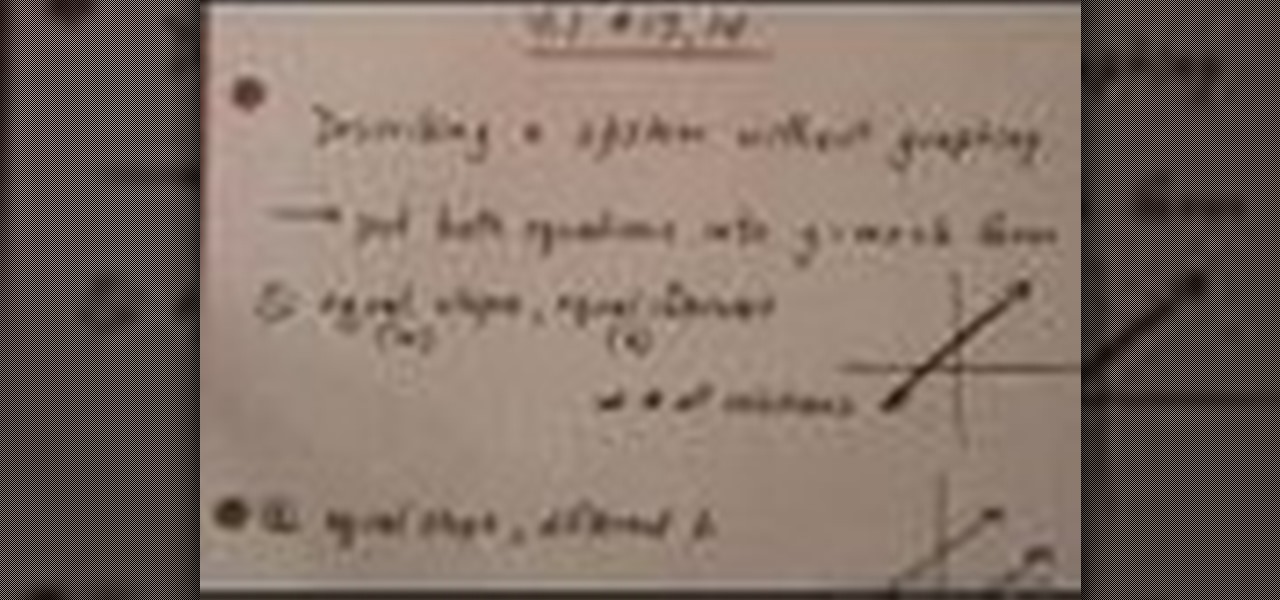
How To: Describe a linear system without graphing
This tutorial looks at how to describe a linear system without actually graphing it. In order to do that, you will need to convert both equations of a problem into the Y=mx+b format. Once you have done this, you will be analyzing the m and b values. There are a few rules to follow. If the slopes (or m) and the Y intercepts (or b) are equal, there are an infinite number of solutions (or dependent equations). A second rule is if the slopes are equal and the Y intercepts are different, then the ...

How To: Do algebraic long division
In this video, you can learn how to do algebraic long division. Take an easy example, such as 88 divided by 4. You are actually dividing 4 into 88. You take the 4 and divide it into the 80, and your answer is 20. Multiply (20 x 4) and you get 80, then subtract the 80 from 88 and you get 8. You then divide 4 into the remaining 8 and your answer is 2, giving you a final answer of 22. Try a harder problem, such as 2105 divided by 12. You are dividing 12 into 2105. The easiest way to handle this ...
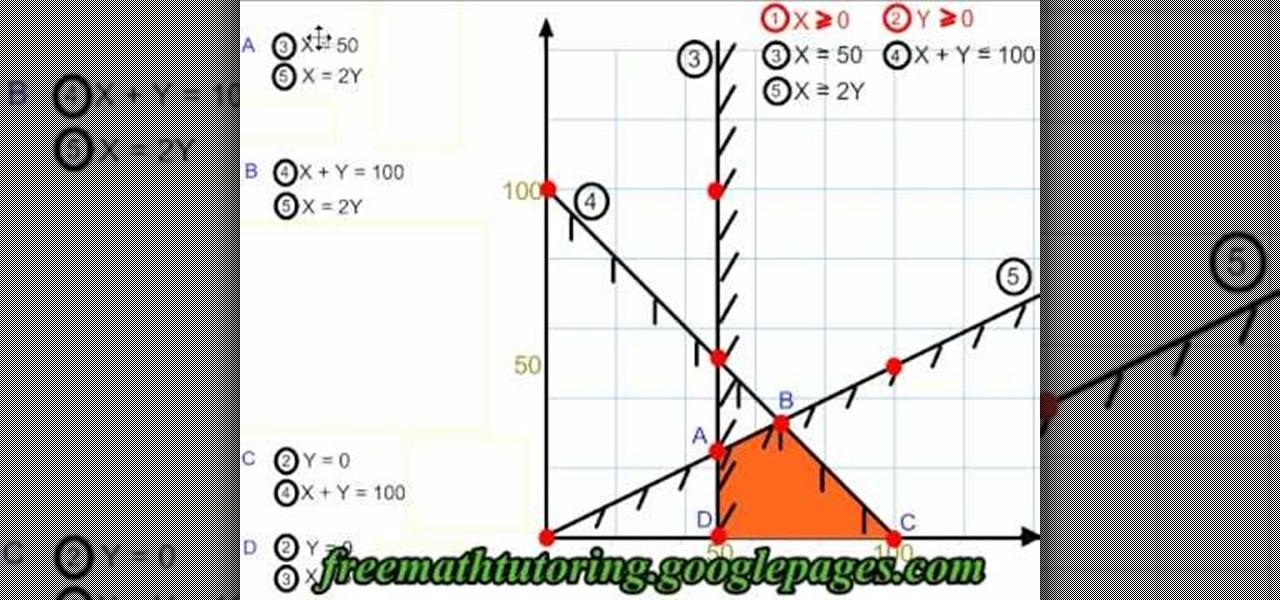
How To: Find the vertices of a polygon of constraints
In this tutorial the instructor shows how to find the vertices of a polygon of constraints. In any optimization problem after defining your polygon you need to find its vertices. First you will have a set of equations which represents the constraints in your problem. Now you have to find the coordinates of the vertex of it by solving the optimization problem. To do that you have to start with a point and check the lines that are passing through it. Now take those lines and solve them for the ...
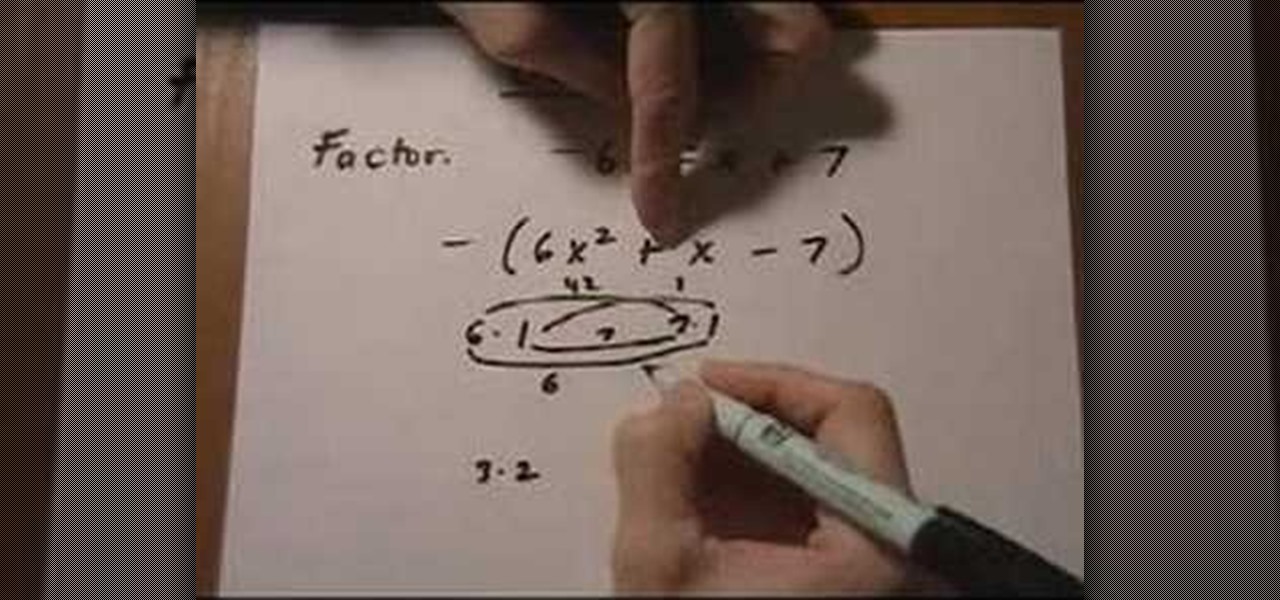
How To: Factor a trinomial with a negative in front
This video shows the method to factor a trinomial with a negative sign in the front. The first step is to make the first term positive. This is done by taking the negative sign out. Then we see the middle term of the trinomial. The coefficient of the middle term is a positive one in the example shown. We have to group the coefficient of the first and third term in a way so that the difference is positive one. The appropriate combination is chosen so that this becomes true. In this way the tri...
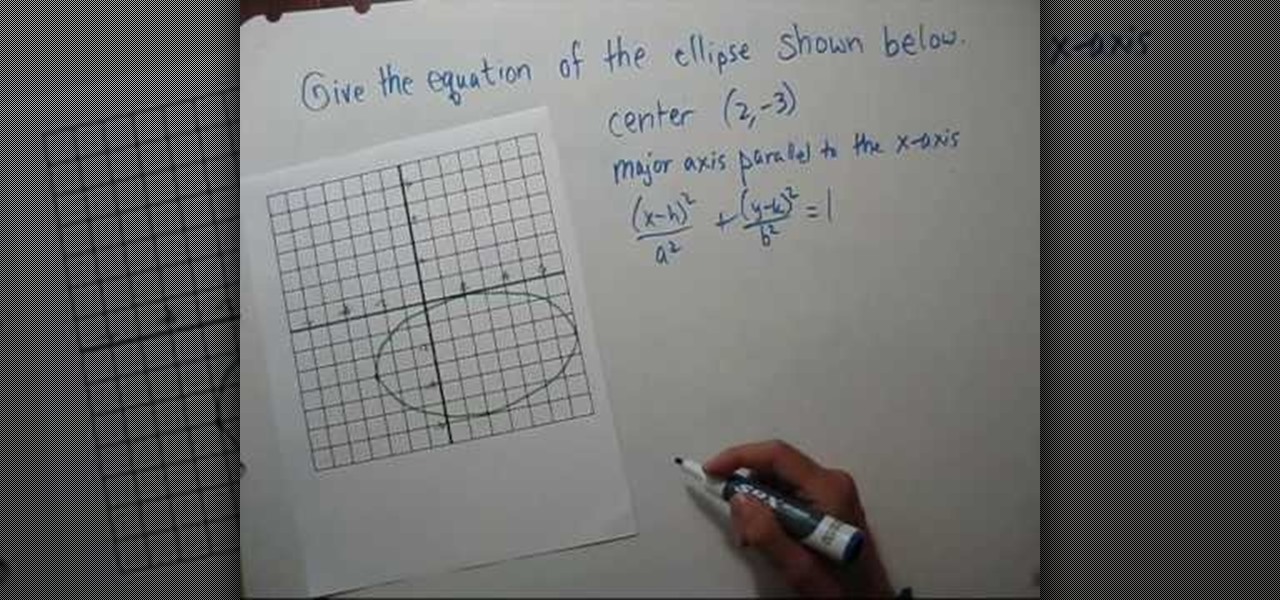
How To: Find the equation of an ellipse given a graph
Notes College Algebra teaches you how to find the equation of an ellipse given a graph. You first want to find out the center of the ellipse, which in the video is (2, -3). The major axis is parallel to the X axis. The equation is (x - h) squared/a squared plus (y - k) squared/a squared equals 1. A is the distance from the center to either of the vertices, which is 5 over here. B is the distance from the center to the top or bottom of the ellipse, which is 3. You then use these values to find...
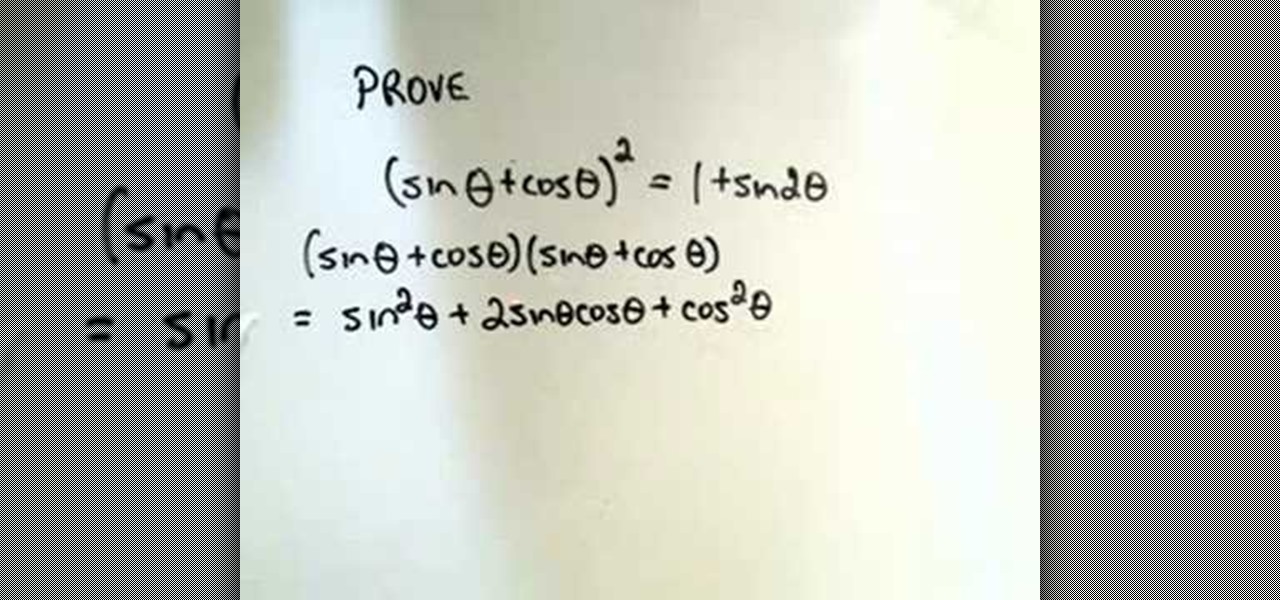
How To: Prove some random trigonometric identities
This video shows the method to prove some trigonometric identities. This involves the use of algebra and knowledge of basic trigonometric identities. The video demonstrates three examples to illustrate this problem and its solution. The first problem shows a relatively simple problem involving sines and cosines. The video shows some basic algebra steps to simplify the problem and prove the identities. The second example involves a slightly complicated problem involving square of combination o...
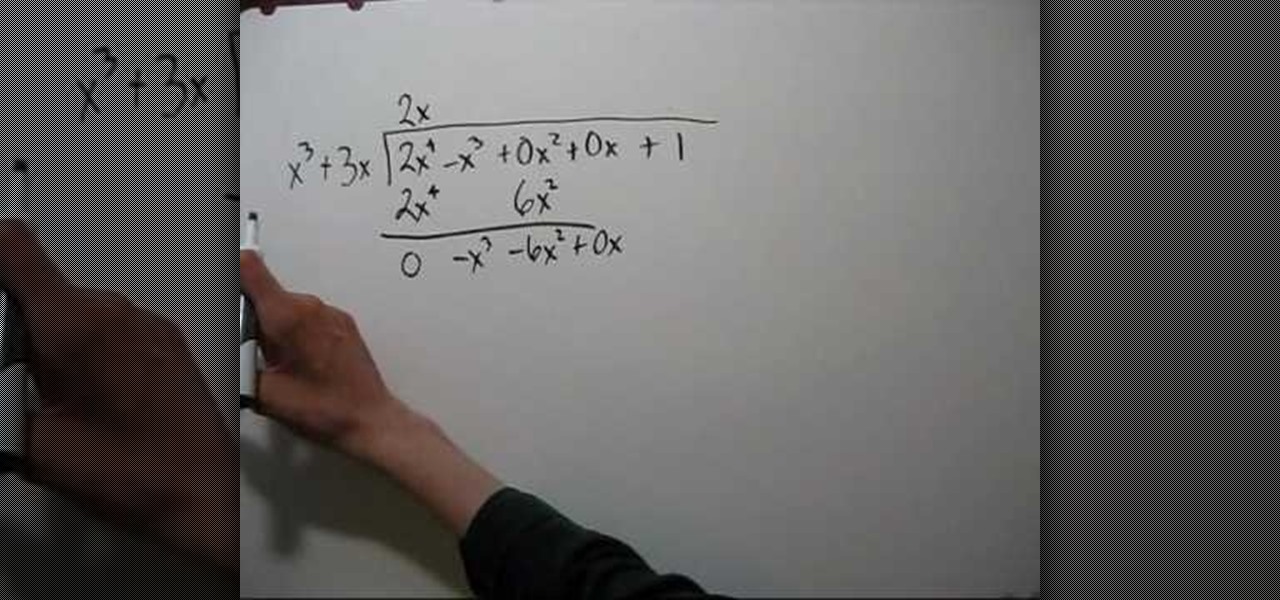
How To: Find slant (oblique) asymptotes of rational functions
In this educational video the instructor shows how to find the slant asymptotes of rational functions. Slant or oblique asymptotes occur when the degree of the numerator is exactly one greater than the degree of the denominator of the rational function. The way to find the equation of the slant asymptote from the function is through long division. In this long division you divide the numerator with the denominator by following the long division method as shown in this video. Before dividing i...
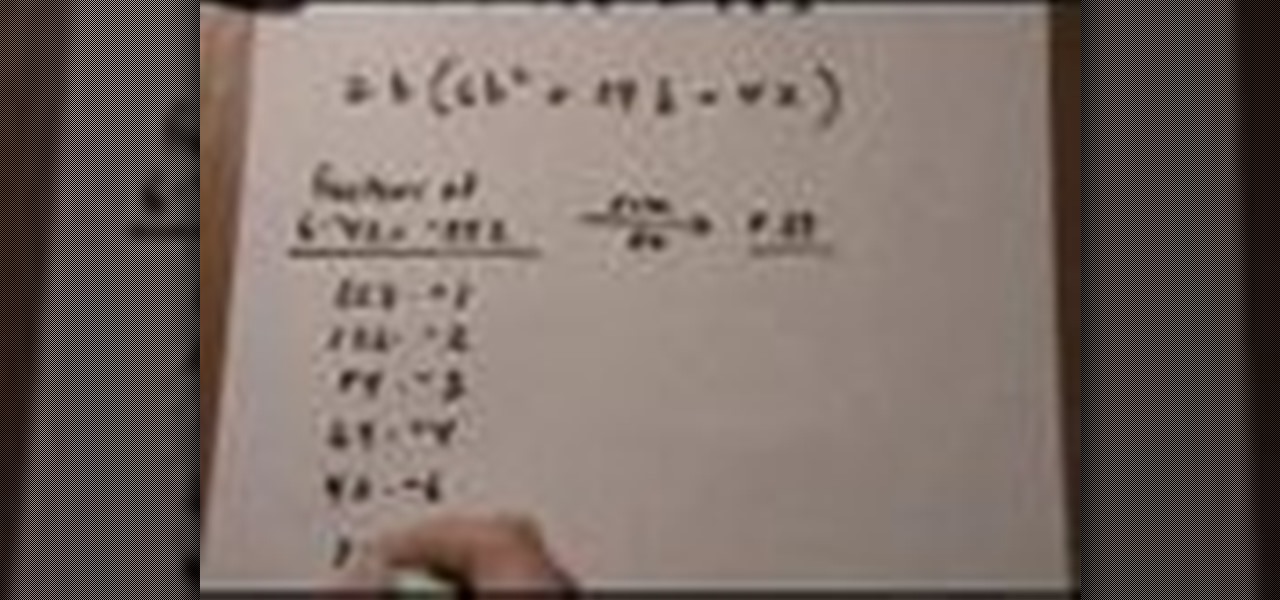
How To: Factor trinomials by GCF, grouping, unfoiling
Factoring trinomials can be a daunting task for many people. If your in need of extra help Denise Robichaud has created a step by step video that shows how to factoring trinomials by the greatest common factor (GCF), grouping, and unfoiling. She gives tips that help get you started, for example when factoring a trinomial first try to pull out a GCF, and if you have 4 terms try factoring by grouping. The video gives you a chance to work at your own pace. Seeing factoring problems solved with a...

How To: Multiply mixed numbers easily
This video tutorial shows you how to multiply mixed numbers. When doing this the first thing that you want to do is put the mixed numbers into a improper fraction form. From this step you can simplify the numbers based on what you are using. In this case you can take out the 3 and 21 and simplify it to 1 and 7 respectively. From here you do the basic multiplication to get one improper fraction. Then turn this number back into a mixed fraction to complete your problem.
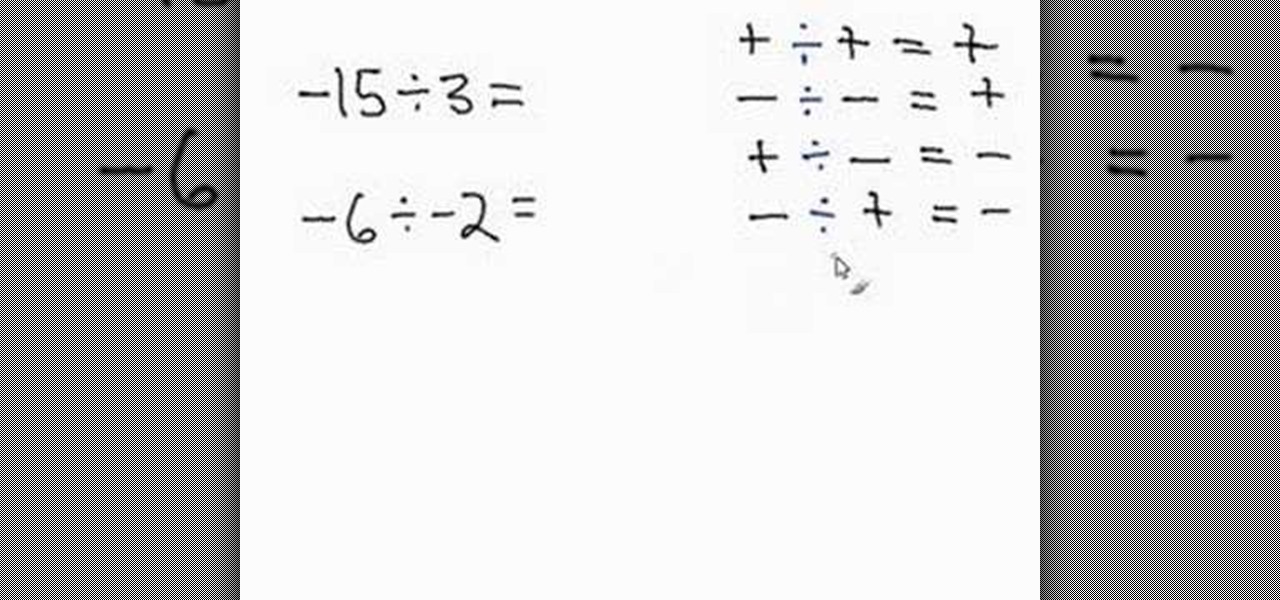
How To: Divide integers quickly and easily
This tutorial explains how you can divide integers. Dividing integers is similar to multiplying integers. A positive divided by a positive gives you a negative number. A negative divided by a negative gives you a positive number. And a positive divided by a negative, or a negative divided by a positive, will results in a number. Some examples: -15 divided by 3. In this problem we're dealing with a negative divided by a positive. So, the answer will be negative. The answer is -5. Another examp...

How To: Derive the basic area of a triangle
In this video tutorial, viewers learn how to solve the area of a triangle. The formula for the area of a triangle is A = ½ x b x h or bh/2. The base of the triangle is always at the bottom; it is the side that the triangle sits on. The height is the length between the base and the highest point of the triangle. Multiply the base and height of a triangle; then divide by two or multiply by half. The measurement unit of the answer should be squared. This video will benefit those viewers who need...
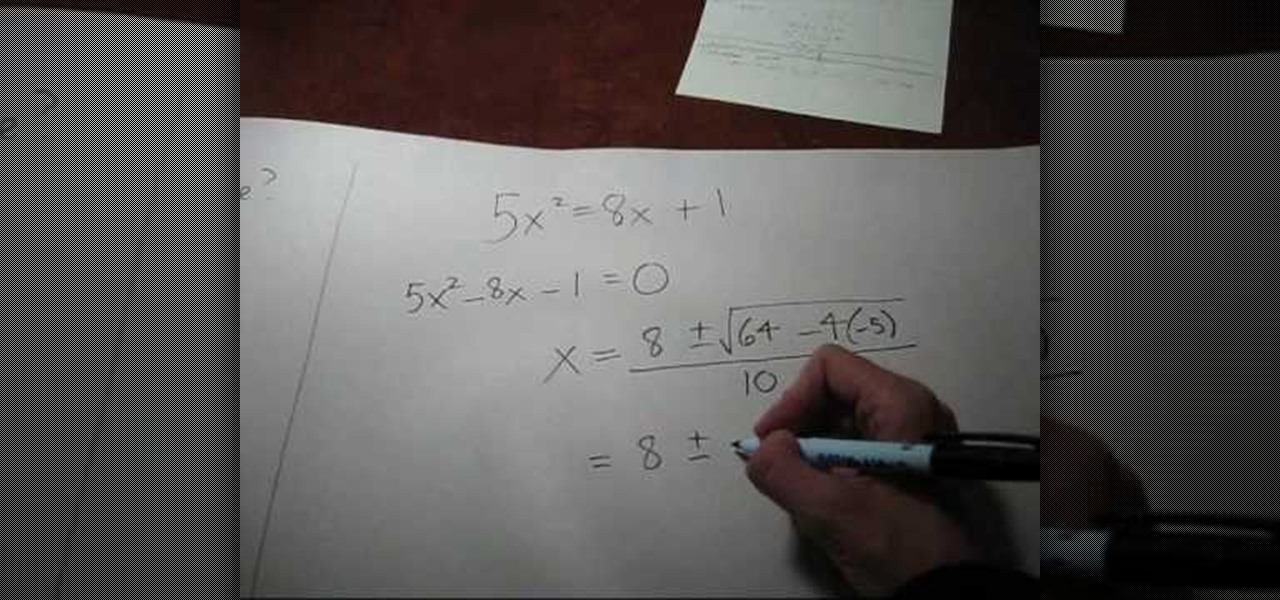
How To: Simplify a quadratic formula result
In this video the tutor shows how to simplify a quadratic formula result. You can solve a quadratic equation using the quadratic formula. The first thing you have to do when given the quadratic equation is bring all the terms to one side so that you have a zero on the other side of the equals to sign. Now the formula to calculate the roots of the quadratic equation ax*x + bx + c = 0 is x = (-b + root of(b*b - 4*a*c) ) / 2 * a. The other root can be obtained by using the minus sign before the ...

How To: Find the Percent Given Two Numbers
Whether you're shopping for deals, need help with a little math, or any number of other occasions, it's a valuable skill to know how to quickly figure out a percentage given two numbers.

How To: Find the greatest common factor (GCF)
This video tutorial shows you the proper way to find the GCF, or greatest common factor. While this is not necessary, the video shows a method of drawing a T chart. List both the numbers that you need to find the GCF, then list there factors, including the number 1. Once you display your factors of both numbers it is a clear cut visual of what the GCF is. In the case of the problem on the video the number 4 has factors of: 1, 2, 4 and the number 20 has factors of: 1, 2, 4, 5, 10, and 20. Ther...
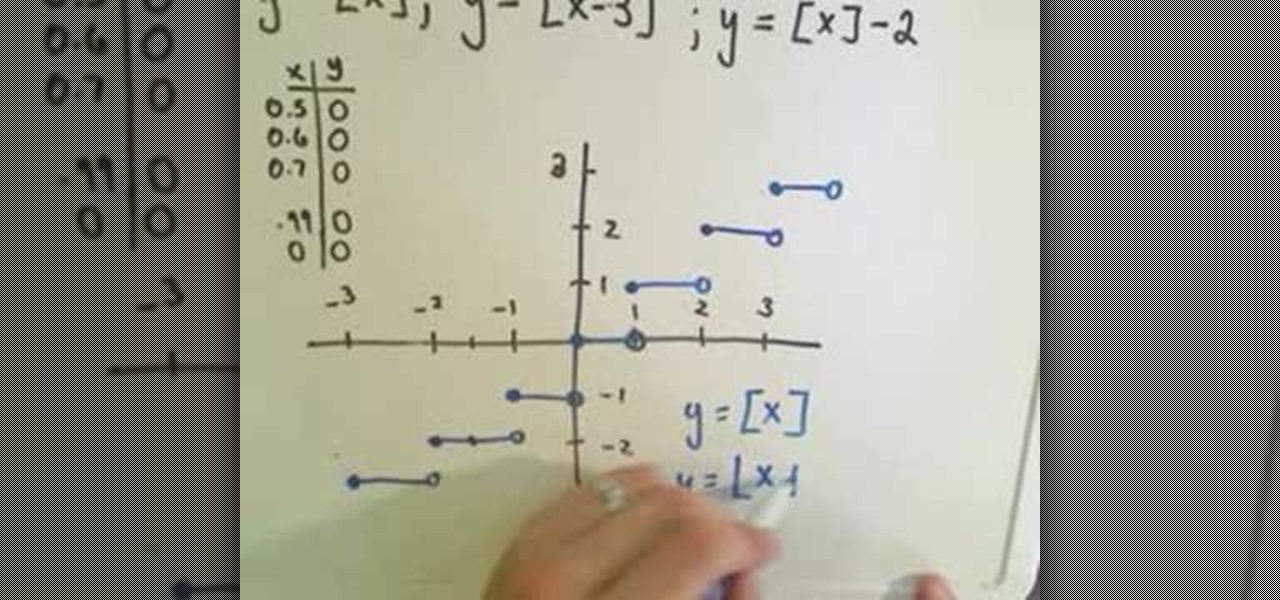
How To: Graph the greatest Integer or floor function
The video shows the explanation of greatest integer function. This video explains this with the help of graphs. The video first describes the basic greatest integer function. This means the greatest integer less than or equal to the number gave. The graph of this function is drawn. The video then shows the variations of this function. The first variation shows the function that replaces the 'x' coordinate with it subtracted by three. This shifts the graph to the right by three units. The seco...

How To: Simplify square roots easily
robichaudd teaches you how to simplify square roots. When you're dealing with variables, even powers and you want to find out the square root of it, you follow the process. Divide the power by the root, which is two, because it's a square root, that gives you what comes out. If we have square root of x squared, the result would be x. So the square root of x to the 6 is x cubed. You simply divide the power by two, since we are dealing with square root. Then square root of 36 times x square is ...

How To: Figure out circumference with given radius
Here Mr Misonet tries to teach to compute circumference of a circle when radius is given. First he convince you the formula. The circumference of a circle is proportionately equals to "pie" times of its diameter,where the value of "pie" is equal to 3.14 and diameter is equal to two times radius. Then he puts the value of the diameter of the given circle and calculate the value of the circumference and also make you understand how to multiply the numbers with decimals. And lastly he makes your...
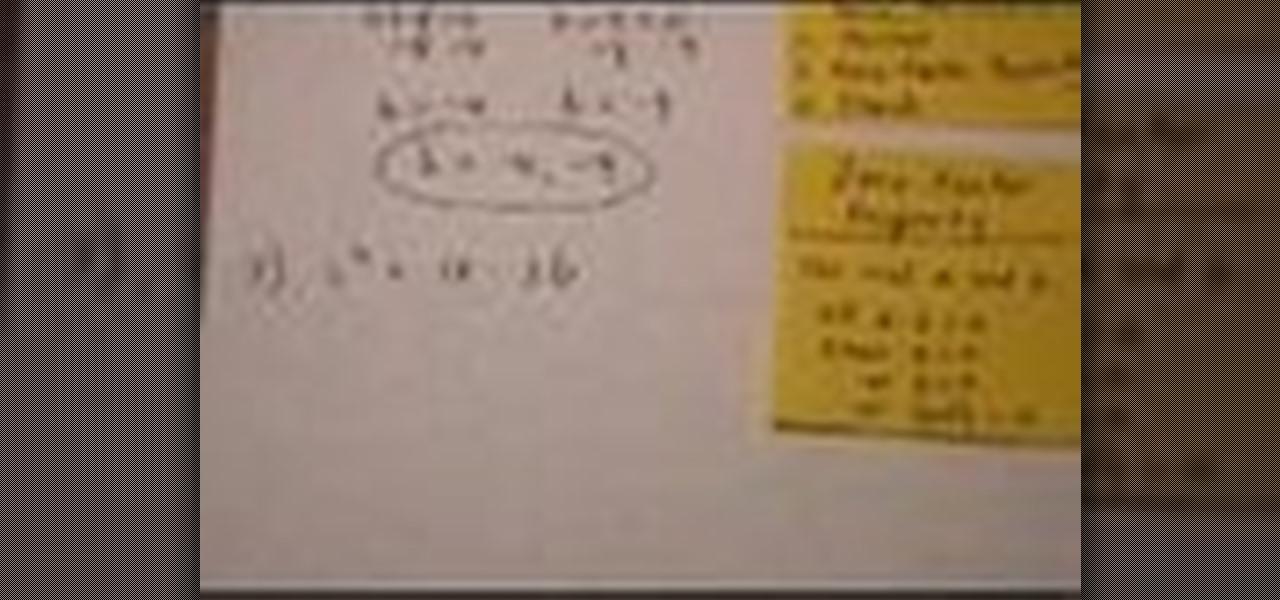
How To: Solve quadratic equations by factoring in math
In this video the instructor shows how to solve quadratic equations by factoring. You can solve a quadratic equation by factoring them. To do this first write the equation in the standard from which is a*x*x + b*x + c = 0. Now factor the equation into two smaller equations of single degree. Now you can apply the zero-factor property to solve the equation in this from. The zero-factor property states that for a real values a and b, if a multiplied by b is equal to zero then value of a must be ...

How To: Simplify algebraic equations w/ the minus-one trick
Just follow a few steps to simplify algebra with the minus one trick. First step is to take two algebraic equations with having numerator and denominator algebraic equations. Second step is to divide the denominator with numerator. For example, it have like -c/c, it gives like answer as -1, but we have another type like (c-a)/(a-c) - to solve these types of steps, like multiply numerator with minus(-), it gives the common the minus and -(a-c)/(a-c), then it gives -1 as a answer.

How To: Multiply or divide rational expressions
318770 Multiply or divide rational expressions. Here Ms Robichaudd guides you nicely that how to multiply or divide rational expressions. She starts with divide and simplify. In first step she shows you how she multiplied and flip. And then to simplify it more she took out the common factor from the bracket to cancel the same numbers from numerator and denominator. In next step she multiplied across and got the final answer. And then she gives other example, Multiply and Simplify. Here again ...
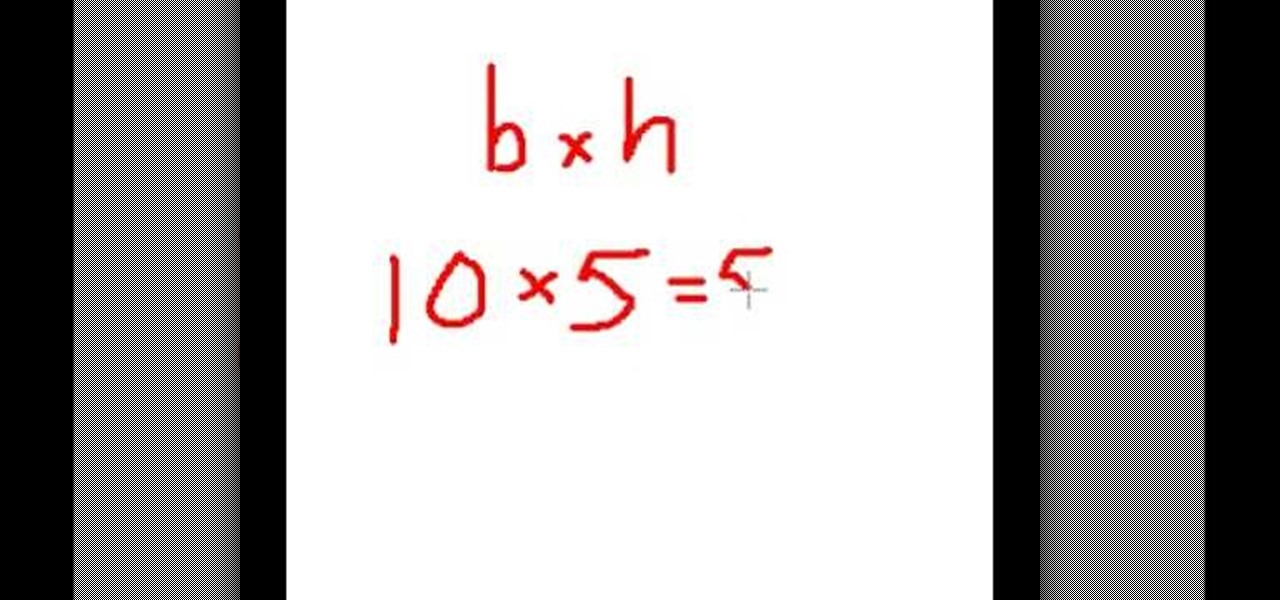
How To: Find the area of triangles
Are you horrible at math? Are you unable to calculate the area of a triangle? This video will teach you how to calculate the area of a triangle! By showing you every step towards solving the area of a triangle slowly, it feels as though a tutor is actually teach you in person. Upon finishing the video, you can finally understand that homework problem that asks for the area of a triangle. Watch this video today! (It's cheaper than a tutor.)
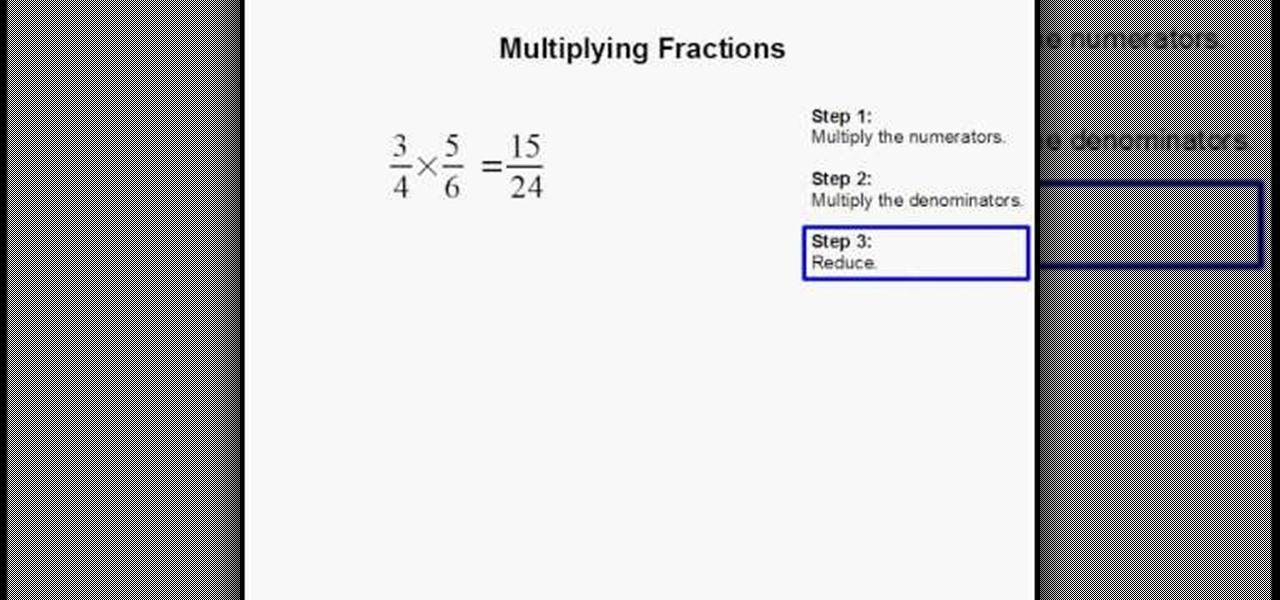
How To: Multiply fractions together
Do you hate fractions? Do you hate fractions even more when you have to multiply fractions together? This video will show you how to multiply fractions with ease. By the usage of a simple step-by-step process, the video demonstrates the steps used to multiply a fraction as well as explaining each of the steps in words rather than expecting a person to understand what is happening without prior knowledge. By finishing this video, you'll be able to multiply fractions!
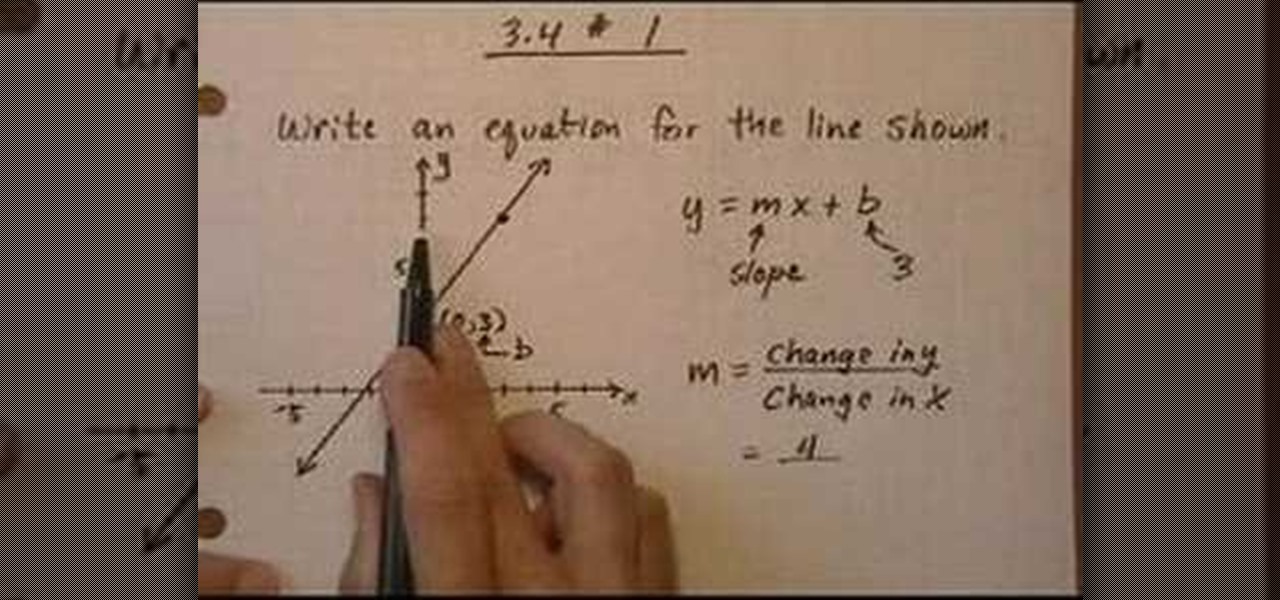
How To: Find the equation of a line easily
This is the video about how to Find the equation of a line. The equation of a line with a defined slope m can also be written as follows: y = mx + b where m is the slope of the line and b is the y intercept of the graph of the line. The above form is called the slope intercept form of a line. Step1 Set m to a fixed value (m = 1) and change b (b = 1, 2, 3, 4, -1, -2, -3, -4). Compare each value of b to the y-intercept of the line obtained. Step2 Set b to a fixed value (b = 1) and change m (m =...

How To: Divide proper fractions
This video shows you how to easily divide proper fractions. In the first step, you have to calculate how many times does the denominator fit into the numerator. You need to divide the numerator by the denominator. If the denominator does not fit into the numerator, you have to write 0, followed with a point, at the top of the calculation ("0."). Next, you add a 0 next to the numerator (multiply it by 10). Now, you have to calculate how many times does the denominator fit into the numerator ag...

How To: Solve a quadratic equation by quadratic formula
This video is describing how to solve quadratic equation by quadratic formula. The quadratic equation is given in the video and we will use quadratic formula. We will put the equation in the formula our equation is 4psquare= -23p - 15. Now add 23 to both sides and then add 15 to both sides now we will get an easy equation, 4 will be used as a and 23 will be used as b and 15 will be used as c and we have a=4,b=23 and c=15 put these values in the quadratic formula and we have the value of p=5.-...
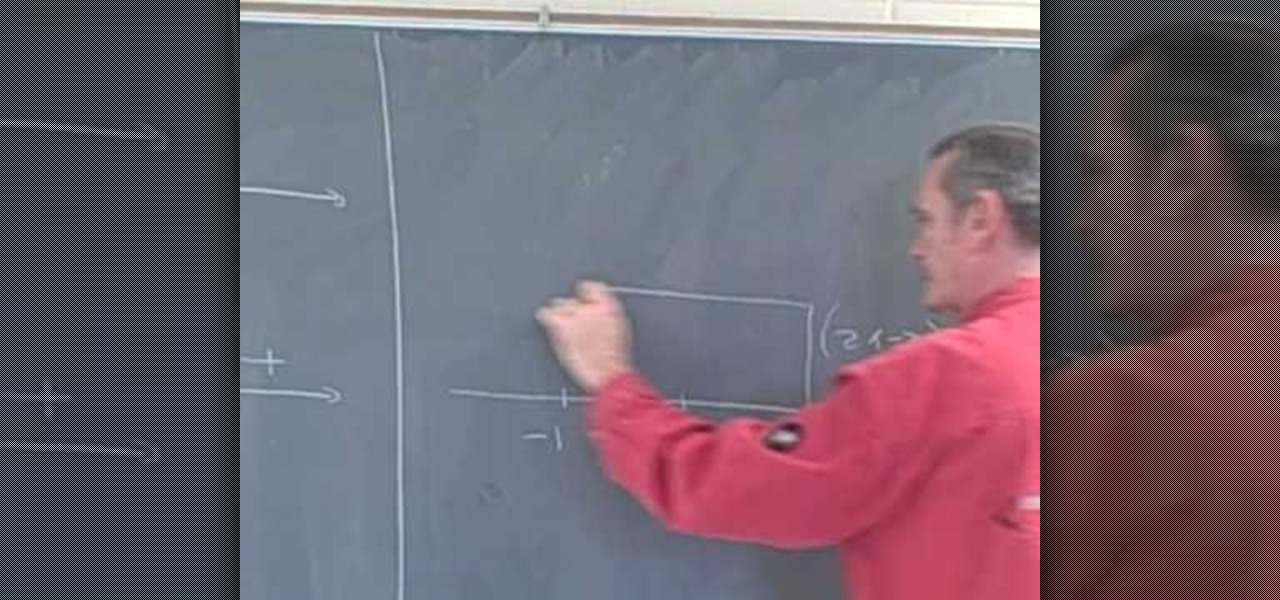
How To: Solve rational inequalities using sine charts
When you are solving inequality for a rational function you don't do it the same way as you would solve an equality. Now the instructor shows how to solve an inequality with the help of an example. Now to solve an inequality which is in the form a/b first take the numerator and denominator as separate equations of two lines. Now graph the two lines on coordinate axes. Using the graphs of the lines plot the intercepts of the equations on the number line noting down the sings. Now you can compa...




